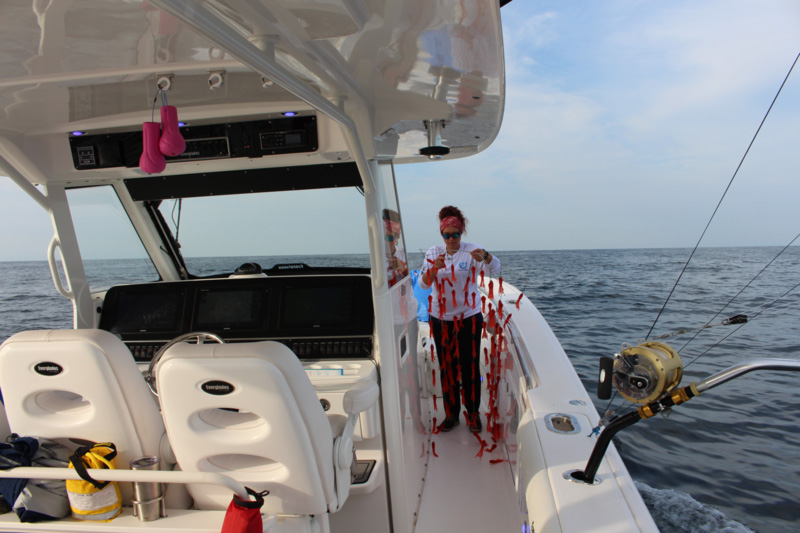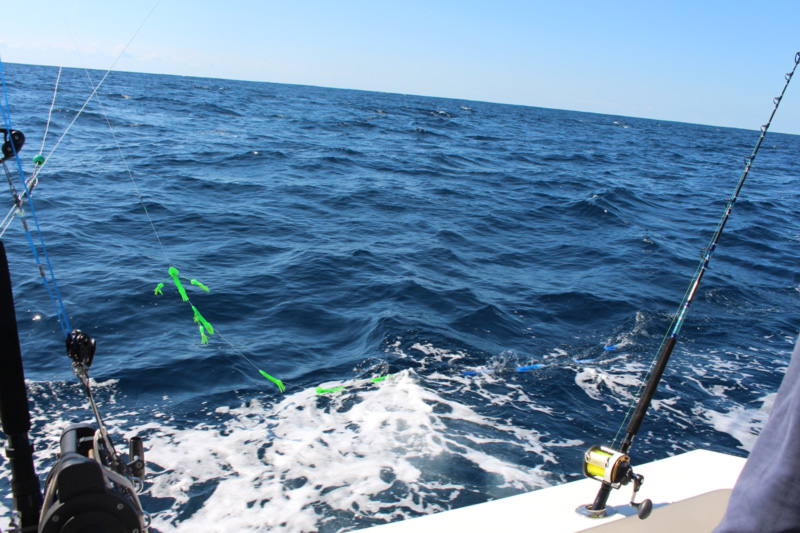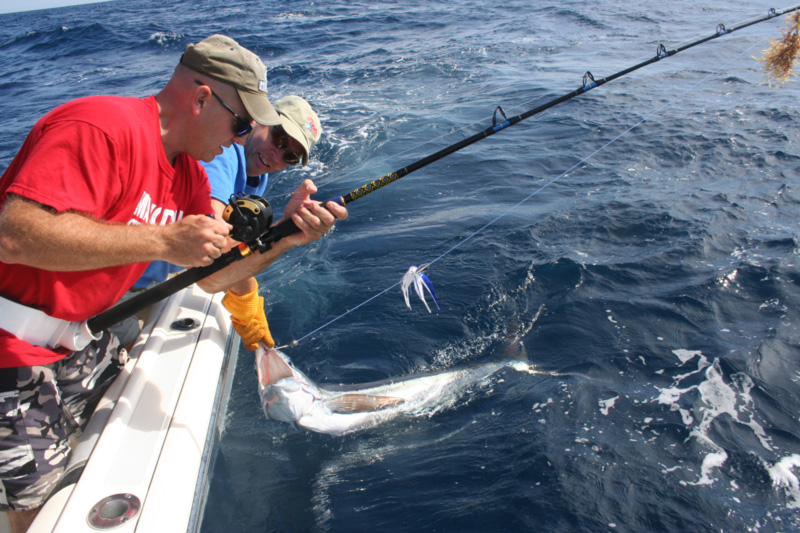Whether you’re hoping to compete in a big money billfish tournament like the WMO or you just want to feel the rush of battling with a billfish, if you own or fish from an outboard-powered boat you’re at a disadvantage when compared to the big dogs. It’s often said that your boat is your biggest teaser, and there’s undoubtedly some truth to this. The deep thrumming of inboards and their big props creates a lower-frequency call that attracts those predators, a fact that’s been proven by taking recordings of the underwater sounds different power systems make, and then having ichthyologists compare them to the frequencies already knows to attract pelagic predators. So, are you just going to shrug your shoulders and accept that the 50-footer over there will catch two billfish to every one you manage to hook up? Aw, heck no — it’s time to even the odds a bit.

Choosing the Best Billfish Dredge
The first thing you need to do is offer the fish something big and beautiful to help lure them into your spread, and dredges are the answer. Dredges attract fish to your spread, period, and as an added bonus their appeal isn’t just limited to billfish. Tuna, wahoo, and other predators are also brought in by their visual display and you’ll often find that the ballyhoo you run 10 feet or so behind the dredge gets the most hits of the day regardless of which species you’re talking about.
Dredges can be broken down into two basic categories: natural and artificial. Some pros believe that natural dredges made with dozens of ballyhoo and/or mullet are impossible to beat with plastic and Mylar artificials, but some others have come to feel that modern artificial dredges are just as effective. When it comes to small boat anglers, however, the fact is that that few of us have the time (or the professional mate we can hand the task off to) nor the budget to harness an entire school of dead baits to a dredge before going fishing. As a result, the majority of the small boats out there today will be found towing an artificial dredge. So for the purposes of this article we’re going to stick with artificial dredges, only.

Artificial dredges can be broken down into three main categories: plastics, holographics, and skirts. Plastics can be found with anywhere between a couple dozen and a couple hundred squid or fish of varying colors, shapes, and sizes. The downside to these dredges is that they’re bulky and can be difficult to both stow and deploy. Holographic “strip” dredges, which tow plastic film embedded with Mylar fish or squid, flash and dance very much like baitfish and certainly do look like a baitball underwater (at least when viewed from above). They’re also incredibly easy to stow since the dredge arms collapse and the whole affair fits into a mesh bag. Skirt dredges, which depend on colored skirts to create the profile of baits underwater and often incorporate mylar strips to add some flash, are similarly realistic looking when towed through the water. They’re almost as easy to stow and deploy as most holographic dredges, and are a bit less expensive than most other options.
Which of these is best? That depends entirely upon whom you ask. You can also split the difference by rigging two in tandem, with a small “school” of plastics on one set of arms a few feet in front of a second set pulling strips or skirts (my personal preference).
How to Run a Dredge
As a dredge runs through the water, it creates a huge amount of resistance. This can make deploying and retrieving them difficult and even a bit dangerous. If you’re running a boat with electric dredge reels, you can run the dredge line off an outrigger ring and have a huge advantage. You just press a button, and up it comes to clear the water for the fight. But many small boat anglers have neither the cash nor the wiring for this sort of rig, and will hand-deploy. The easiest way of accomplishing this is by cleating the line off on the stern. Here's a quick how-to video giving the basic rundown on deploying a dredge.
Manually deploying a dredge is a two-man operation (one to handle the dredge and one to handle the line), and it requires slowing the boat. Bringing the dredge back in requires slowing the boat to an absolute crawl, and it will still be a workout for anyone doing it by hand. Since you’ll usually be bringing the dredge in to clear the way while fighting a hot fish, you need to get that dredge out of the water as quickly as possible. In this case, Mylar strips and tinsel skirts again have an edge because they’re easier to deal with than plastics. They create less water resistance which means you can yank them up faster, and they weigh a lot less so you can pitch them into the bow or drop them into the motor well much more easily. So if your boat isn’t rigged with electric dredge reels and especially if you’re running the dredge by hand off a cleat, strips and skirts are usually the way to go.
Regardless of type, every experienced angler will agree that two key factors to effectively running it include getting it into clean water, and getting it down below the surface. Getting the dredge down two to six feet (most pros believe that generally speaking, deeper is better) requires six to 10 pounds of lead. Rigging a monster lipped plug in front of the dredge became popular a few years back and adds yet another teaser into the mix, but the practice became a bit less attractive to some folks when it was discovered that on occasion a wahoo would take a swipe at it and cut your expensive dredge right off. Roll the dice as you please.
Another thing serious anglers generally agree upon is that while you want to get that dredge down to clean water, you should always be able to see it so you can watch for fish. Quite often you’ll see a billfish come in hot and bat at the dredge, giving you the opportunity to present a pitch bait. For small boat anglers this can be a real quandary. On a big sportfisher with a flying bridge, a dredge running six feet deep can be watched without a problem. On a small boat with an upper-station or a crow’s nest, you may need that dredge running at four feet to keep an eye on it. And from the deck of a small center console, if you don’t keep the dredge close to the surface you may not be able to see a thing. Note, however, that no matter what sort of boat you have you absolutely must make sure the dredge runs deep enough that the dredge arms stay completely submerged at all times. Otherwise they’re guaranteed to grab a flat line, and create one heck of a nasty tangle.
Teasers for Marlin

While the dredge grabs attraction beneath the surface, surface teasers grab it from above. Splishing, splashing, gurgling, popping teasers of all sorts can be employed to bring those billfish right up to the junction between ocean and atmosphere, where they’re easy to spot and bait from any sort of boat. For this reason, it’s always good to keep a teaser out especially from small boats with no high fish-spotting positions. If a billfish approaches a dredge from below and bats at it, when there’s a surface teaser close by there’s a good chance the frustrated fish will switch up and make an attack run on it, too. And in that scenario, it’ll be much easier to spot for a bait-and-switch.
Teasers come in all shapes and sizes, and it’s not unheard-of to pull wacky things like a two-liter Coke bottle with a handful of rocks inside, a boat fender, or a modified bowling pin, with excellent results. Most anglers, however, will stick with tried-and-true options like daisy chains (often terminating with a hook-free rigged ballyhoo, which many Carolina boats pull religiously when tuna trolling as well as when billfishing), bird chains, or more recently, Flippy Floppies. While all can be run with hook-baits behind them, these rigs can also be run hook-free purely in teaser mode.
Whether you’re talking dredges or teasers, the basic concept is the same: use these tools to attract billfish to the boat, where you can offer them a rigged ballyhoo or a similar line via a pitch-bait kept at the ready. For small boats, however, consider two additional factors: there’s a good chance you don’t have the room or the gear necessary to constantly have pitch-baits at the ready, and there’s a good chance that without eyeballs on a flybridge, you won’t quickly spot the billfish (especially if it’s on a dredge). For these reasons, the best move is usually to have a very generic dink naked ballyhoo running on a flat-line in close proximity to the dredge. There’s a good chance that bills on the dredge will spot it and go for the easy meal that appears to have become separated from its “school,” and if/when you do spot a bill, you can pop the flat line clip and move the rod to direct the ballyhoo in front of the fish and then drop it back.

Utilizing this gear and these tactics, will the average guy on his 26-foot outboard boat be able to compete on an even playing field with the 50-footers? Heck no. Those big boats still put out those deep harmonics, have endless stowage and bottomless gear budgets, professional crews on the deck, and more eyeballs to watch the spread from better positions. But you can employ dredges and surface teasers to shrink their inherent advantage. And whether you’re a gambling man fishing for dollar bills or an ambitious angler looking for thrills, that means you shouldn’t ever leave the dock without ‘em.
For more info on the actual baiting and hooking of billfish, see Billfish Special Part I: Finding and Baiting Marlin.